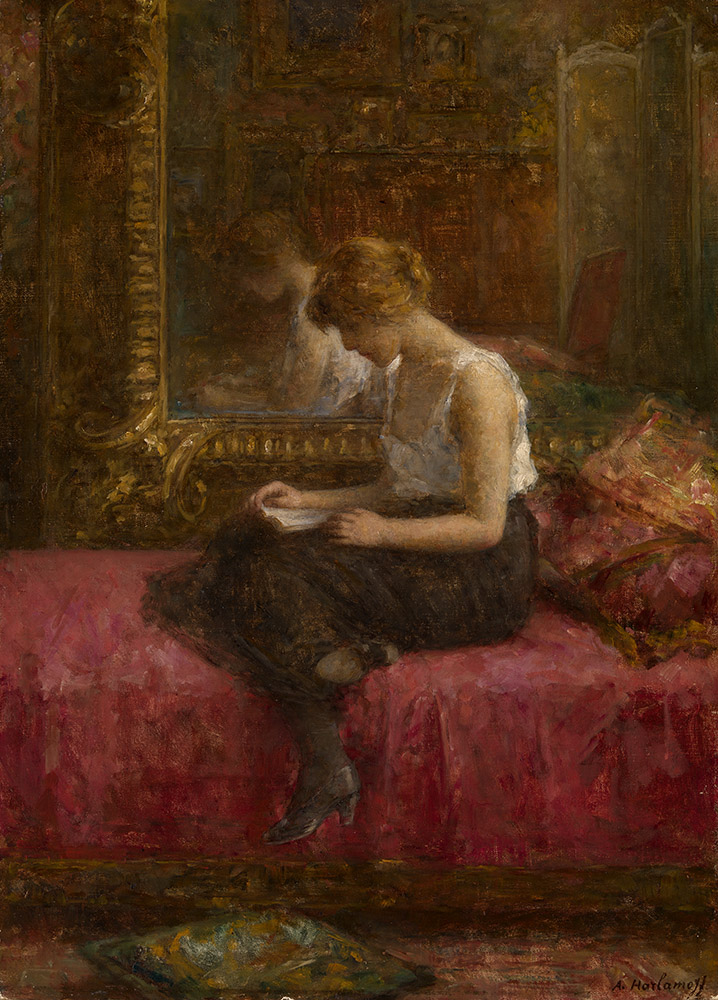MacDougall Auctions 2-3 December 2009
2 December 2009

268. HARLAMOFF, ALEXEI 1840-1922
Girl Reading signed
Oil on canvas, 56 by 40.5 cm.
100,000-150,000 pounds
Provenance: Anonymous Sale; Sotheby’s London, May 2002, Lot 59.
Private collection, UK.
Authenticity has been confirmed by Vladimir Petrov.
Literature: O. Sugrobova-Rot, E. Lingenauber, Alexei Harlamoff. Catalogue Raisonne, No. 183, plate 176, illustrated.
The image of a girl reading is one of the most perpetual and romantic images in the history of art. Whether sitting, standing or reclining, dressed in the latest fashion or naked, lovely maidens with a book or letter in their hands constitute some of world’s most renowned masterpieces.
The creative oeuvre of Harlamoff, who devoted himself entirely to this eternal subject, coincided with a general fascination with “mood”, vivid emotion and the pursuit of the portrayal of natural behaviour by posing models that was in evidence towards the end of the 19th century. It is therefore unsurprising that the image of “the girl reading” became one of the favourite motifs of the sensitive and talented portraitist.
The work currently presented at the auction was executed between the end of the 1900s and the beginning of the 1910s. It portrays a young girl reading rapturously and sitting comfortably with her legs crossed on a divan in the artist’s studio on 57b Boulevard Rochereau in the artists’ favourite quartier at the lower end of Montmartre.
A large wooden writing desk, framed paintings, a screen, and other accoutrements of a fashionable art studio are reflected in a massive gold framed mirror hanging over the divan. This not only breaks up the space but also makes an inadvertent reference to the traditions of classical art. This allusion is all the more obvious in the work Reading, which, notwithstanding its horizontal format, has much in common with the composition presented at the auction. Here the viewer sees an already familiar interior and a girl reading, as if some time has gone by: a pillow has been lifted from the floor, a divan covered with a fashionable new rug, and the young reader, buried in her book and tired after a prolonged period of immobility, has undressed and is already lying on the divan in her little black slippers just as before, her eyes glued to the fascinating tale, the pages of the book obviously nearing their end. Most importantly, the viewer can see the artist holding a palette in an old Venetian mirror behind her. This is very obviously reminiscent of the masterpieces of Van Eyck, Velasquez, and Rembrandt.
Harlamoff ’s love for “Dutch miniatures” is also brought to mind by his mastery of conveying the texture of the glistening expensive fabric of the divan cover and his painstaking attention to detail in the background, which, in both versions of this composition, the artist entices us to peer at closely in the dull receding gloom behind the mirror.
After completing a trip to Belgium and Holland in the early 1870s, Harlamoff assiduously studied the works of the old masters, copying a large number of them, in particular Rembrandt’s The Anatomy Lesson of Doctor Tulp for the Museum of the Academy of Arts. The artist’s interest in the Dutch domestic genre of the 17th century had, however, in all likelihood begun even before his trip. Thus in 1869 he had created the canvas Grandmother with Her Little Grandson, which can be found in the Russian Museum. This was followed by the watercolour Mother and Child in the Kitchen and the works The Music Lesson, Story Time, as well as a variation on this theme, Learning to Read. The artist’s stay in the Netherlands, however, provided his creative oeuvre with a new lease of life. From then on, he would never fail to introduce something of the “Dutch miniatures” in his canvases of interior scenes “from 19th- century life”, creating his own version of realism enveloped in the flair of refined retrospectivism.
However, even retrospection was invariably transformed by Harlamoff ’s brush into a fashionable trend of international salons. His life models were cut from the same cloth as the universalised modern ideal, and his interiors would not look out of place in any corner of Europe, whether in Britain or Norway. It is no coincidence that Harlamoff ’s renowned Finnish contemporary, the artist Albert Edelfeld, when preparing his mise-en-scene of Girl Reading, chose exactly the same female type and the same setting consisting of a creative studio with a massive “antique” dresser. On the wall he even hung the same rug that covers the divan in Harlamoff ’s Paris studio.
In the 1900s, despite Harlamoff ’s faithfulness to the traditional colours of “old-style painting”, his painting style became freer. By creating a number of variations of one and the same composition, the artist was striving to convey the surroundings of light and air and emphasise the “plein air” nature and freshness of the moment captured in his work. With this in mind, Harlamoff would test various techniques when working on a painting. Thus, for example, the artist created a composition in pastels similar to ours, portraying the same female life model (Sotheby’s, London, June 23, 1983, lot. 605).
Notes on symbols:
* Indicates 5% Import Duty Charge applies.
Ω Indicates 20% Import Duty Charge applies.
§ Indicates Artist's Resale Right applies.
† Indicates Standard VAT scheme applies, and the rate of 20% VAT will be charged on both hammer price and premium.